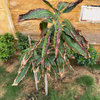Well, 99% of the flowers on my Sweetheart Lychee have fallen off and there does appear to be a descent amount of ovaries swelling up. I hand pollinated as many of the female flowers as I could but I wonder if it will actually be detrimental because with hand pollination, I would assume that both the ovaries may develope which may decrease the overall size of each fruit. Does anyone know if both ovaries are pollinated, will both fruit develope or can the tree decide to abort one of the fruit?
I have noticed that some of the female flowers has three stigmas and also 3 ovaries. I took some pictures but have troubles with my new camera software. I will post some pics as soon as I find out how to use the software. I hand pollinated some of these and it will be interesting to see if I can get a triplet Lychee.
Each of my panicles has approx 5-10 developing female ovaries. I will try to count how many I have next week so we can keep track of the attrition. I have just added some organic Bone meal for Phosphate and Potash and also some Kelp/Fish emulsion for micronutrients and a little bit of Nitrogen. I expect some vegetative growth soon so I will water in some Chelated Iron very soon.
For us small backyard Lychee growers, I experimented with differnt ways to hand pollinate and found a technique that may be useful for those with very small trees and want to get just a few fruits. If you have larger trees or don't have time to hand pollinate, it will be much easier to plant flowers that attract bees and let Mother Nature do her thing.
I first tried collecting lots of male flowers and putting them into a container and shaking it up in order to shake the pollen off and stick to the container but this method was messy and many of the males I plucked off were not releasing pollen. Often only one or two of the pollen sacs were releasing pollen. By plucking off many male flowers, I am decreasing the overall amount of pollen that Bees and other insects may have otherwise been able to use to pollinate the females.
I also tried plucking individual stamens off the males and individually touching each female stigma with the pollen sac but I noticed that I often plucked male stamens that were not even releasing pollen yet.
I finally came up with brushing my fingers gently over many male flowers that appeared to be in the correct stage for pollen release and this technique seems to be the most promising. When you brush your fingers over the males, you can actually the yellow pollen stick to your fingers. I then get a #2 or #3 natural brush and pick up this pollen from my finger tips and start pollinating the females. After pollinating several females, I will rub my fingers on some more pollen sacs to reload my brush. Because my fingers sometimes got sweaty, I refined this method and found it easier to use black porous paper making it easier to spot the pollen and also to avoid sweaty fingers.
I'm not sure if there has been any research looking into what time of the day the females are actually receptive to pollen but I pollinated my tree around 5-6pm everyday when I got off work. I did pollinate several flowers early in the morning on the weekends but just to be safe, I would recommend pollinating as often as you can and at different times of the day. I would guess that the flowers are receptive as long as the females white stigmas are newly open and still white. They appear to be white for only about 24 hours and start turning brown after that.
The important thing when hand pollinating is to make sure you are actually using good newly released pollen. Don't assume that those large yellow pollen sacs are all releasing viable pollen. Also, I have to make a correction. In a previous post, I said that the yellow pollen sacs didn't or may not release pollen because they were not fully mature but they actually can be. I have seen yellow pollen sacs and the slightly older tan pollen sacs release pollen. For my tree it appears that the yellow pollen sacs that are rough release the most pollen. The large, smooth round yellow pollen sacs appear to not be fully mature and I believe they appear slightly rough once they open up and release pollen.
I'll try to add some pics soon.











jsvand5
hmhausman
Related Discussions
SoCal Sweetheart Lychee update
Q
Sweetheart Lychee observations
Q
Sweetheart Lychee Blooming- December 2009
Q
Any lychee experts around? Trying to distinguish a sweetheart?
Q
red_sea_me
simon_growOriginal Author
jsvand5
hmhausman
simon_growOriginal Author
phase0001
simon_growOriginal Author
hmhausman
simon_growOriginal Author
simon_growOriginal Author
simon_growOriginal Author
puglvr1
simon_growOriginal Author
mango_kush
puglvr1